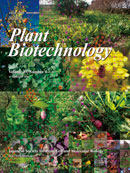33 巻, 4 号
選択された号の論文の14件中1~14を表示しています
- |<
- <
- 1
- >
- >|
Preface
-
原稿種別: Preface
2016 年 33 巻 4 号 p. 211-212
発行日: 2016/09/30
公開日: 2016/11/18
[早期公開] 公開日: 2016/10/26PDF形式でダウンロード (74K)
Review
-
原稿種別: Review
2016 年 33 巻 4 号 p. 213-234
発行日: 2016/09/30
公開日: 2016/11/18
[早期公開] 公開日: 2016/04/21PDF形式でダウンロード (3337K)
Original Papers
-
原稿種別: Original Paper
2016 年 33 巻 4 号 p. 235-243
発行日: 2016/09/30
公開日: 2016/11/18
[早期公開] 公開日: 2016/04/09PDF形式でダウンロード (3492K) -
原稿種別: Original Paper
2016 年 33 巻 4 号 p. 245-253
発行日: 2016/09/30
公開日: 2016/11/18
[早期公開] 公開日: 2016/03/19PDF形式でダウンロード (1094K) -
原稿種別: Original Paper
2016 年 33 巻 4 号 p. 255-265
発行日: 2016/09/30
公開日: 2016/11/18
[早期公開] 公開日: 2016/04/09PDF形式でダウンロード (555K) -
原稿種別: Original Paper
2016 年 33 巻 4 号 p. 267-276
発行日: 2016/09/30
公開日: 2016/11/18
[早期公開] 公開日: 2016/10/22PDF形式でダウンロード (1862K) -
原稿種別: Original Paper
2016 年 33 巻 4 号 p. 277-279
発行日: 2016/09/30
公開日: 2016/11/18
[早期公開] 公開日: 2016/04/09PDF形式でダウンロード (2432K) -
原稿種別: Original Paper
2016 年 33 巻 4 号 p. 281-286
発行日: 2016/09/30
公開日: 2016/11/18
[早期公開] 公開日: 2016/04/09PDF形式でダウンロード (4885K) -
原稿種別: Original Paper
2016 年 33 巻 4 号 p. 287-295
発行日: 2016/09/30
公開日: 2016/11/18
[早期公開] 公開日: 2016/07/14PDF形式でダウンロード (749K) -
原稿種別: Original Paper
2016 年 33 巻 4 号 p. 297-307
発行日: 2016/09/30
公開日: 2016/11/18
[早期公開] 公開日: 2016/09/29PDF形式でダウンロード (2723K)
Short Communication
-
原稿種別: Short Communication
2016 年 33 巻 4 号 p. 309-314
発行日: 2016/09/30
公開日: 2016/11/18
[早期公開] 公開日: 2016/04/21PDF形式でダウンロード (379K)
Notes
-
原稿種別: Note
2016 年 33 巻 4 号 p. 315-321
発行日: 2016/09/30
公開日: 2016/11/18
[早期公開] 公開日: 2016/10/22PDF形式でダウンロード (2286K) -
原稿種別: Note
2016 年 33 巻 4 号 p. 323-331
発行日: 2016/09/30
公開日: 2016/11/18
[早期公開] 公開日: 2016/10/22PDF形式でダウンロード (4585K) -
原稿種別: Note
2016 年 33 巻 4 号 p. 333-339
発行日: 2016/09/30
公開日: 2016/11/18
[早期公開] 公開日: 2016/11/09PDF形式でダウンロード (771K)
- |<
- <
- 1
- >
- >|
